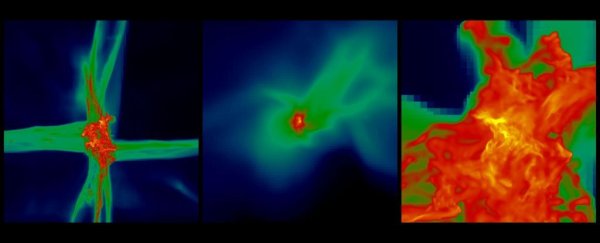Over the last few years, as we have been able to peer back deeper and deeper into the early Universe, astronomers have been discovering something extremely puzzling.
Before the Universe was a billion years old, giant black holes up to over a billion times the mass of the Sun had already somehow formed. Given what we know about black hole formation and growth, the presence and size of these behemoths is extremely challenging to explain. How did they get there, so soon after the Big Bang? And how did they get so danged big?
Now, supercomputer simulations have revealed an origin that explains how they formed without the need for exotic conditions: rare reservoirs of turbulent cold gas that collapsed into stars more massive than anything in the Universe today. These would have been the huge seeds that grew into supermassive black holes.
"We find supermassive black holes at the centers of most massive galaxies today, which can be millions or billions of times the mass of the Sun. But back in 2003 we began finding quasars – highly luminous, actively-accreting supermassive black holes that are like cosmic lighthouses in the early universe – that existed less than a billion years after the Big Bang," said cosmologist Daniel Whalen of the University of Portsmouth in the UK.
"No one understood how they formed by such early times. This discovery is particularly exciting because it has overturned 20 years of thought on the origin of the first supermassive black holes in the Universe."
There are two main schools of thought on how supermassive black holes form. The first is the bottom-up model. A single massive star dies, usually leaving behind a black hole up to around 100 times the mass of the Sun.
Over time – lots and lots of time – the black hole slurps up a bunch of material, growing bigger and bigger until it is millions to billions of times the mass of the Sun. This is extremely hard to reconcile with quasars in the early Universe.
The other option is if you start with a really chonkin' big black hole 'seed', up to 100,000 times the mass of the Sun. The stars that collapsed to form these black holes would have had really, really short cosmic lives, maybe 250,000 years, before collapsing into a black hole.
There are no known stars of that mass around today, and we know of no current formation mechanism that could produce them. But simulations have shown that in the early Universe, when conditions were rather different from conditions today, theoretically such stars could have formed at the junctions of rare but powerful streams of dense, turbulent, cold gas.
Cosmologists thought it would take some truly exotic conditions, such as backgrounds of strong ultraviolet radiation, or supersonic flows between gas and dark matter. And none of these exotic conditions resembled the environments in which these early Universe quasars were found.
Led by astrophysicist Muhammad Latif is of the United Arab Emirates University in the UAE, the researchers conducted simulations of the streams of gas, and were delighted to find that supermassive black holes formed at the intersections of these streams spontaneously, without the need for exotic conditions.
In the simulation, the turbulence generated by the intersecting streams prevents normal stars, such as those we see today, from forming. Usually, this happens when a dense knot of material in a cold cloud collapses under gravity to form a baby star, but when there's too much turbulence, conditions aren't stable enough for this to occur.
However, eventually the cloud in the simulation grew so massive that it collapsed catastrophically into two gigantic stars, clocking in at 31,000 and 40,000 times the mass of the Sun.
As gas from the streams continues to feed into the clouds, a supermassive black hole billions of times the mass of the Sun can form and grow in just a few hundred million years.
"Consequently, the only primordial clouds that could form a quasar just after cosmic dawn – when the first stars in the Universe formed – also conveniently created their own massive seeds. This simple, beautiful result not only explains the origin of the first quasars but also their demographics – their numbers at early times," Whalen concluded.
"The first supermassive black holes were simply a natural consequence of structure formation in cold dark matter cosmologies – children of the cosmic web."
The research has been published in Nature.
